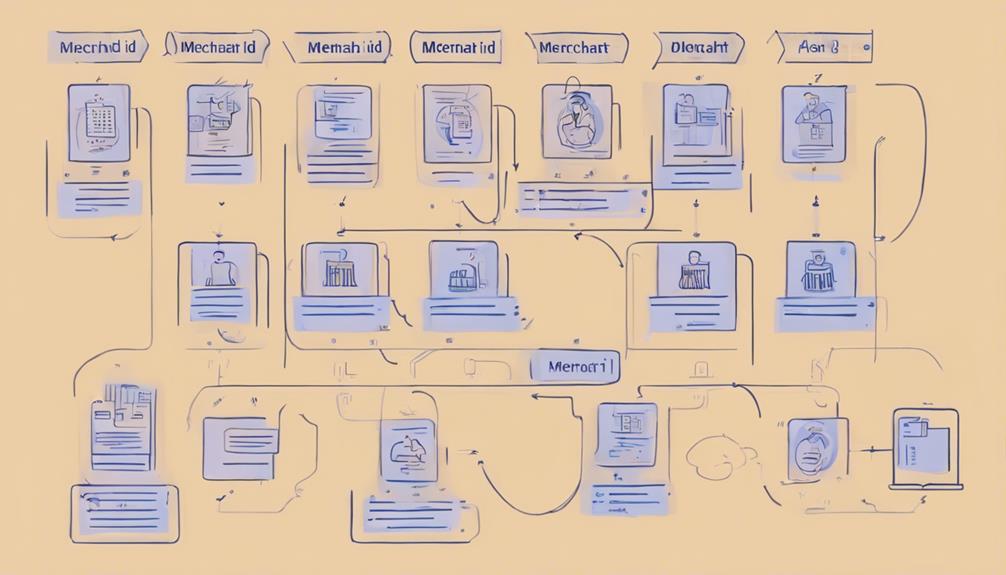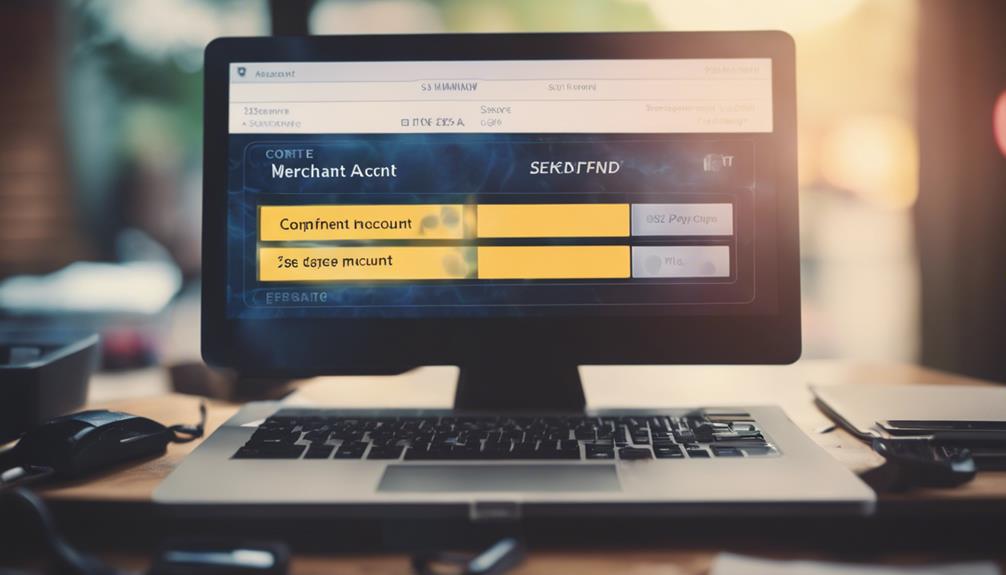To set up a merchant account and accept payments, start by obtaining a business license and opening a dedicated bank account. Make sure your provider supports accepted credit cards and aligns with your business needs. Complete the application with accurate information and prepare necessary documents. Underwriters will assess your application for risk and compliance, leading to approval for credible submissions. Once approved, integrate credit card processing for seamless transactions. Efficient setup guarantees reliable payment processing. Optimizing these steps can enhance your business operations swiftly and securely.
Key Takeaways
- Obtain a business license for legitimacy and compliance.
- Open a dedicated business bank account for credit card sales.
- Choose a provider supporting accepted credit cards and preferred payment methods.
- Complete merchant account application with accurate business and financial details.
- Integrate credit card processing for streamlined transactions and increased sales potential.
Business License and Bank Account Setup

When setting up a merchant account, the initial essential steps involve obtaining a business license to establish your business legitimacy and opening a dedicated business bank account where your credit card sales can be deposited.
A business license serves as proof that your operations are important and compliant with regulations. It signifies to your customers and financial institutions that you're a credible entity.
Opening a separate business bank account guarantees that your credit card sales are securely processed and deposited, keeping your business finances organized and distinct from personal funds. This segregation is vital for financial transparency and accounting purposes.
Evaluating Business Needs and Providers

To evaluate your business needs and select the right provider, consider factors like the types of credit cards you'll accept, preferred payment methods, and future requirements. When appraising merchant account providers, keep the following points in mind:
- Accepted Credit Cards: Confirm the provider supports the credit cards your customers use most frequently.
- Preferred Payment Methods: Choose a provider that offers a variety of payment options, such as online payments, mobile wallets, or recurring billing.
- Future Scalability: Opt for a provider that can accommodate your business growth and evolving payment processing needs.
Considering these factors will help you make an informed decision when selecting a merchant account provider that aligns with your business requirements.
Completing Merchant Account Application

Completing the merchant account application requires providing detailed business information and essential documentation. To streamline the process, make sure you have the following ready:
| Requirement | Description | Importance |
|---|---|---|
| Business Information | Legal business name, address, and contact details. | Essential for account setup. |
| Financial Documents | Bank statements, tax ID, and processing history. | Validates financial stability. |
| Business Registration | Business license, EIN, or Articles of Incorporation. | Confirms business legitimacy. |
Gather these documents to expedite your application process. Remember, accuracy and completeness are key to a successful merchant account setup.
Underwriting Process and Approval

Upon submitting your merchant account application, the underwriting process begins to assess the risk associated with your account and determine approval. Here's what you can expect during this phase:
- Risk Evaluation: Underwriters analyze your business information, processing volume, and financial history to gauge the level of risk associated with your account.
- Compliance Check: The approval decision is based on how well your business aligns with regulations and security standards to guarantee compliance.
- Approval Process: If your application meets the underwriting criteria and demonstrates credibility, you'll receive approval to start accepting credit card payments promptly.
Understanding this process can help you navigate the underwriting stage efficiently and get your merchant account up and running smoothly.
Initiating Credit Card Payment Acceptance

Initiate accepting credit card payments swiftly to streamline your business transactions. By integrating credit card processing, you can enhance customer convenience and expand your sales opportunities. Below is a table outlining the benefits of credit card payment acceptance:
| Benefits of Credit Card Payments |
|---|
| Instant Transaction Processing |
| Increased Sales Potential |
| Improved Cash Flow |
Document Submission and Compliance

For document submission and compliance when setting up a merchant account, gather all necessary paperwork and guarantee adherence to industry regulations.
To secure a smooth process and successful account setup, follow these steps:
- Collect Required Documents: Gather essential paperwork such as business licenses, identification documents, and banking information.
- Verify Compliance: Confirm that all documents meet the required standards set by regulatory bodies and the chosen merchant account provider.
- Maintain Transparency: Be honest and forthcoming during the submission process to avoid delays or issues with account approval.
Obtaining Merchant ID and Account Types

To obtain your Merchant ID and explore the available account types, begin by understanding the specific needs of your business and how different account options can cater to those requirements effectively. Your Merchant ID is automatically provided when you open a merchant account, enabling you to track transactions seamlessly.
If you have bad credit or operate a high-risk business, specialized companies offer tailored solutions. Various account types such as retail, e-commerce, mobile, telephone, and mail-order are designed to suit different business models. Evaluate the nature of your transactions and customer interactions to determine the most suitable account type.
Choosing the right account can enhance your payment processing efficiency and meet your business goals effectively.
Frequently Asked Questions
Can a Business Owner Use a Personal Bank Account for a Merchant Account?
Yes, a business owner can't rely on a personal bank account for a merchant account. It's crucial to have a separate business bank account for credit card sales. This account guarantees proper tracking of business transactions and compliance with financial regulations.
Are There Any Penalties for Early Termination of a Merchant Account Contract?
When terminating a merchant account contract early, there may be penalties involved. These penalties can vary based on the provider and the specific terms of your agreement.
Prior to signing, it's crucial to review the contract thoroughly to grasp any potential consequences of early termination. Make sure to clarify the terms and conditions with your provider to prevent unexpected fees or penalties down the road.
How Can Businesses Handle Chargebacks and Disputes With a Merchant Account?
To handle chargebacks and disputes with a merchant account, it is essential to follow a structured approach:
- Review the reason for the chargeback.
- Respond promptly with evidence such as receipts or tracking information.
- Communicate with the customer and your payment processor to resolve the issue.
- Maintain detailed records of all transactions and communications.
- Implement fraud prevention measures to minimize future disputes.
- Stay informed about chargeback regulations and best practices to protect your business.
Is There a Minimum Transaction Volume Required for a Merchant Account?
There's no set minimum transaction volume requirement for a merchant account, as it varies depending on the provider and your business needs.
Some providers may have specific criteria or recommendations, but it's not a universal standard.
When choosing a merchant account, consider your projected sales volume, transaction frequency, and the associated fees to find the best fit for your business.
Research different providers to find one that aligns with your transaction volume expectations.
Are There Any Restrictions on the Types of Products or Services Allowed for Payment Processing?
When setting up a merchant account, there are regulations regarding the types of products or services allowed for payment processing. Certain industries like gambling, adult content, pharmaceuticals, and illegal activities may face restrictions or require specialized merchant accounts.
It's important to review the terms and conditions of merchant account providers to make sure compliance with their policies on acceptable products or services. Understanding these restrictions can help you navigate the payment processing landscape effectively.
What are the Steps to Set Up a Merchant Account for Accepting Payments?
When setting up a merchant account for accepting payments, there are several steps to follow. First, research merchant account options revealed. Then, choose a provider and apply for an account. Next, set up a payment gateway and integrate it with your website. Finally, start accepting payments from customers.
Conclusion
To sum up, venturing into the journey of setting up a merchant account can open doors to new opportunities for your business. By following the steps outlined in this guide, you can seamlessly navigate the process and start accepting credit card payments with ease.
Remember, the key to success lies in thorough preparation and careful consideration of your business needs and service providers. Take the first step today and unleash the potential for growth and success in your business.










